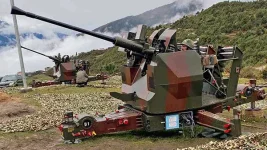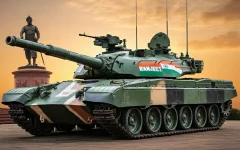- Views: 1K
- Replies: 3
The Indian Army is advancing its air defence capabilities with the successful conclusion of preliminary tests for the AK-630M integrated Mobile Gun System (MGS).
Following these initial evaluations, the system is now set to undergo further, more demanding trials, incorporating minor adjustments based on the feedback received.
This development highlights India's continuous efforts to modernise its armed forces and counter new aerial threats with sophisticated, locally adapted solutions.
The AK-630M, which originated as a naval Close-In Weapon System (CIWS) from the Soviet Union and later Russia, has been reconfigured for ground-based deployment in this mobile gun system.
The core of the system is a 30mm six-barrel rotary cannon renowned for its extremely high firing rate of up to 5,000 rounds per minute. This feature makes it highly effective against low-flying aircraft, unmanned aerial vehicles (UAVs or drones), and incoming missiles.
By mounting this formidable weapon on a mobile vehicle, as shown in images of a truck-mounted turret, the AK-630M MGS gains significant mobility and operational flexibility, enabling quick deployment across various battlefield conditions.
During the recently completed internal trials, the AK-630M MGS showcased its capacity for precise target engagement. This was achieved using its onboard radar and fire control systems, which allow for automatic detection and tracking of threats.
The trials were designed to assess the system's effectiveness in simulated combat situations, focusing on its reaction speed, accuracy, and overall dependability under different operational stresses.
Reports suggest the system performed proficiently, effectively neutralising practice aerial targets. However, some areas were identified for enhancement, leading to the planned modifications.
The use of a multi-axle military truck as its platform ensures that the AK-630M MGS can accompany mechanized army units, offering continuous air defence protection for moving ground forces. The turret system, featuring a noticeable radar dome and the distinctive six-barrel cannon, is engineered for swift response.
This capability is increasingly vital given the growing threat posed by drones and low-altitude aerial incursions, which have become prominent features in contemporary conflicts worldwide. The proliferation of such threats necessitates rapid-reaction point defence systems like the AK-630M.
The forthcoming phase of testing is anticipated to include more rigorous field trials, potentially conducted in realistic operational settings. These extensive tests will serve to confirm the system's performance after the current alterations are implemented.
Key aspects to be evaluated will include the AK-630M MGS's ability to integrate with the Army's wider air defence network, its resilience in challenging environmental conditions, and its effectiveness against a broader spectrum of aerial threats, including more advanced drones and precision-guided weapons.
The Indian Army's objective is to ensure this mobile gun system meets the exacting standards required by modern warfare, where speed, precision, and adaptability are critical.
The development and planned induction of the AK-630M integrated MGS form part of India's comprehensive strategy to strengthen its overall air defence framework, especially in light of evolving security challenges in the region.
With sophisticated systems such as the S-400 long-range surface-to-air missile system and indigenous developments like the Akashteer command and control system already operational, the AK-630M MGS will provide an essential short-range protective layer. This new system will complement longer-range air defence assets, contributing to a more robust, multi-tiered national air defence shield.
Its mobility and firepower make it particularly well-suited for safeguarding forward-deployed military units and vital installations from unexpected aerial attacks.




